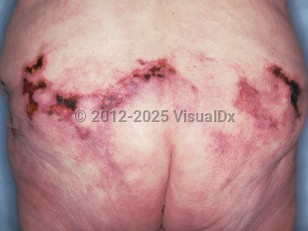Cholesterol embolization, on the other hand, refers to the release of cholesterol crystals into circulation following plaque rupture or disruption. These crystals result in occlusion of smaller vessels, generally involving arterioles (less than 200 micrometers diameter). The crystals occlude arterioles by 2 mechanisms. First, the crystals physically block smaller arterioles. Second, they activate complement, inducing an inflammatory response, which leads to adventitial fibrosis and obliteration of the vessel lumen. Because emboli are small and numerous, this leads to multisystem disease.
The classical clinical triad attributed to cholesterol embolization includes the development of livedo reticularis, acute renal failure, and peripheral eosinophilia, but in clinical practice, the presentation can be varied depending on the location of the source plaque and the degree and location of embolization. For example, ascending arch emboli generally involve the head, eyes, and upper extremities, while those involving the descending arch more commonly affect the abdominal viscera and lower extremities.
The term cutaneous cholesterol embolism signifies involvement of the skin due to cholesterol embolism. It is also referred to as cholesterol embolization syndrome, lower extremity atheromatous emboli syndrome, and purple or blue toe syndrome.
Cholesterol emboli can occur as a result of invasive coronary procedures such as major vessel surgery, angiography, angioplasty, or following anticoagulant or thrombolytic therapy. Anticoagulants and thrombolytics act by targeting the breakdown of the protective clot that stabilizes an ulcerated atheromatous lesion, thereby releasing cholesterol crystals into the bloodstream. Heparin, warfarin sodium, and streptokinase have been reported as causative agents. Formation of cholesterol emboli may also follow cardiopulmonary resuscitation. Rarely, cholesterol embolization can occur spontaneously without any preceding intervention.
Cholesterol embolization is more common in men, typically aged 60-70 years.
Risk factors:
- Extensive atherosclerosis
- Systemic hypertension
- Diabetes mellitus
- Angiography
- Anticoagulation
- Thrombolysis
- Vascular intervention such as angiography, heart catheterization, coronary artery bypass grafting, and percutaneous transluminal coronary angioplasty.
The prognosis is poor, as renal failure is progressive, frequently requiring dialysis permanently, but occasionally renal function will stabilize or improve. Ischemic changes of limbs often lead to gangrene and subsequent amputation. Death most often occurs from cardiovascular causes, and the mortality rate stands at 78%, as seen in one study.



